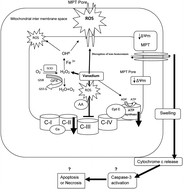Toxicity of vanadium on isolated rat liver mitochondria: a new mechanistic approach
Abstract
Vanadium as a trace element is considered essential for animals; however it has not yet been recognized as a

Maintenance work is planned for Wednesday 1st May 2024 from 9:00am to 11:00am (BST).
During this time, the performance of our website may be affected - searches may run slowly and some pages may be temporarily unavailable. If this happens, please try refreshing your web browser or try waiting two to three minutes before trying again.
We apologise for any inconvenience this might cause and thank you for your patience.
* Corresponding authors
a
Department of Pharmacology and Toxicology, Faculty of Pharmacy, Shahid Beheshti University of Medical Sciences, Tehran, Iran
E-mail:
j.pourahmadjaktaji@utoronto.ca, j_pourahmad@sbmu.ac.ir
b Department of Pharmacology and Toxicology, Faculty of Pharmacy, Zanjan University of Medical Sciences, Zanjan, Iran
c Department of Pharmacology and Toxicology, School of Pharmacy, Mazandaran University of Medical Sciences, Sari, Iran
d Department of Pharmacology, School of Medicine, Tehran University of Medical Sciences, Tehran, Iran
Vanadium as a trace element is considered essential for animals; however it has not yet been recognized as a

 Please wait while we load your content...
Something went wrong. Try again?
Please wait while we load your content...
Something went wrong. Try again?
 Fetching data from CrossRef.
Fetching data from CrossRef.
This may take some time to load.
Loading related content
